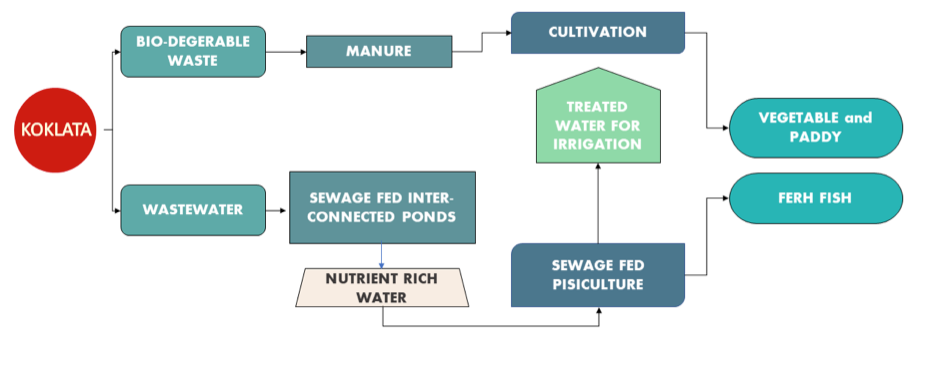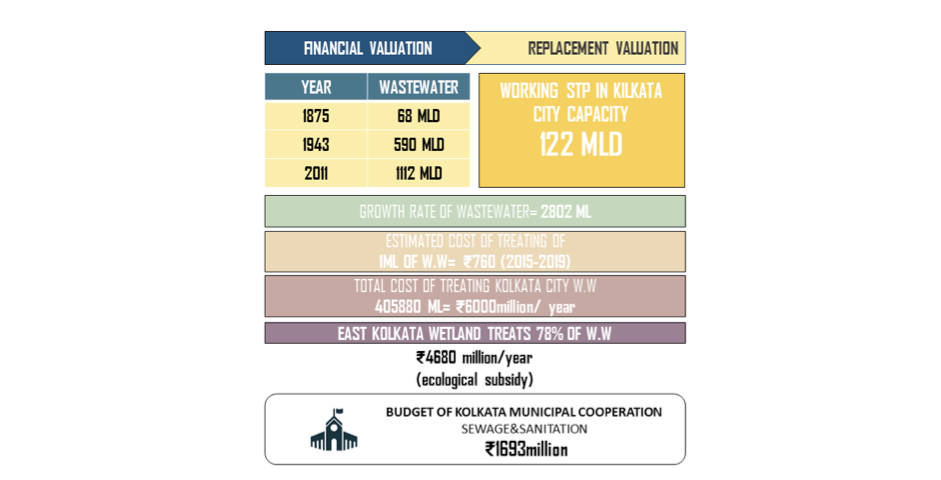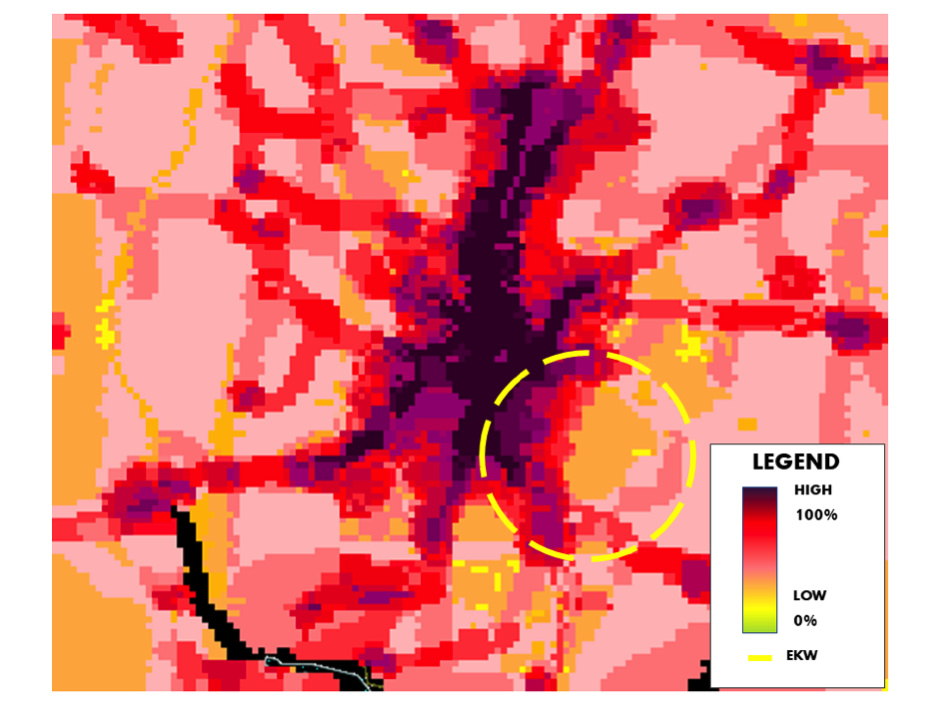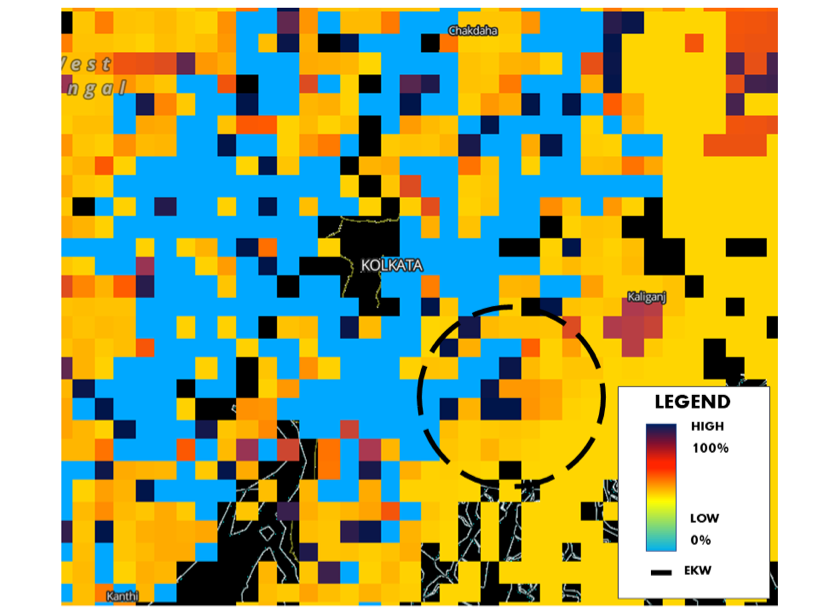what does satellite imagery say about kidneys of kolkata?

Do you know there exists an environmental component that provides flood protection in coastal and urban areas by acting as nature’s sponges, preserves rainwater, recharges aquifers, reduces the risk of storms, absorbs 30% of carbon from the atmosphere, is home to an estimated 1,00,000 species, source of fresh water and food for millions and the most important part it provides resilient against climate change?
Most people would think it is either rainforest, grassland or marine ecosystems to the contrary all these services are provided by one entity which is the Wetlands and the list of benefits goes on, far outnumbering any ecosystems in terms of services though they only cover 3% of the landmass in the globe.
Most residence who lives alongside a wetland misinterpret them to be either large drainage system or dump yards, as according to Ramsar studies they found that almost 64 % of wetlands have disappeared from the earth’s surface since 1900.
This can be for them being water-saturated that gives their unpleasant marshy and boggy features which are disdained by locals and a primary reason for their abandonment.
But unlike human wetlands or peatlands are an important tourist destination for all types of migratory birds be it small and timid nutmeg mannikins or slaty-black bodied Eurasian coot, almost more than a lakh birds migrate during the winter months in the wetlands of West Bengal alone.
The intrinsic value of wetlands was globally recognized on 2nd February 1971 when a convention took place in an Iranian city of Ramsar known as “Convention of Wetlands” which opened the door to its formal environmental conservation.
On the same day fifty years later in the present year of 2021, World Wetland Day was celebrated and the Minister of State for Environment, Forest and Climate Change announced the establishment of a Centre for Wetland Conservation and Management (CWCM) as a part of the National Centre for Sustainable Coastal Management (NCSCM).
This means that research needs and knowledge gaps will aid through the application of an integrated approach of conservation along with building a network with national and international agencies which will facilitate proper policy design and implementation.
Wetland as Kidneys of a City
The city of Kolkata, is the capital of the eastern state of West Bengal, having a population of forty-five lakhs with an additional burden of another 6 million floating day-time population according to Census 2011.
The city generates a total of 1,112 million litres of sewage per day but the challenge of managing, disposing and treating wastewater is not done by a government institution. But the city has been blessed with a system of natural wastewater treatment that also supplies tons of fish and vegetables every year, allowing the megapolis to grow and prosper.
The deeds done by the East Kolkata Wetlands (EKW) (220 27’ N 880 27’ E), located on the eastern fringes of Kolkata city bordering the Salt Lake Township on the one hand and the new township at Rajarhat on the other, forms one of the largest assemblages of sewage fed fish ponds distributed across the districts of South and North 24 Parganas, which also gives it the title of “Kidneys of Kolkata”.

Chronology of Kolkata Wetland
The process of land formation in this region has largely been influenced through centuries by the Ganges river system where upland and tidal depositions continue to create land. The tributaries and distributaries of the river were active in this area many years ago. Before the establishment of Calcutta, the salt-water lake formed here was a backwater swamp and spill area of the Bidyadhari River. The wetlands in those days had utility only from the defence perspective owing to challenges presented to navigation.

Livelihood Provider for Millions in Kolkata
These wetlands form a part of the extensive inter-distributary wetland regimes formed by the Gangetic Delta. EKW sustains the world’s largest and perhaps oldest integrated resource recovery practice based on a combination of agriculture and aquaculture. It provides livelihood support to a large, economically underprivileged population of around 20,000 families which depend upon the various wetland products, primarily fish and vegetables for sustenance. The water flows through fish ponds covering about 4,000 ha.
Based on its immense ecological and socio-cultural importance, the Government of India declared EKW as a Wetland of International Importance under Ramsar Convention in 2003.


Human Encroachment in Wetlands
Wetlands can be the best example for Garret Hardin’s famous theory titled “Tragedy of Commons”, where he highlighted that a natural resource can be exploited due to its vague ownership status and that one act of greed can jeopardise the existence of an entire resource. The same can be said about the East Kolkata Wetlands as the ownership status are unclear and land prices of marshy lands being low priced, illegal encroachers tend to suck in as much land as possible.
From satellite imagery, these can be divided into three types of land conversions which were identified in favour of urban settlements, viz.,
(a) from water body to urban settlement,
(b) from agricultural field to urban settlement and
(c) from open space to urban settlement.
It is interesting to note that most of the changes have taken place in mouzas (administrative unit) where the average sizes of the water bodies are either small or at most medium and is definitely below 8,000 square meters.

Figure 5 Human Activity 
Fig 7 : Urban Vegetation 
Fig 8 : Urban Expansion
This pattern of land conversion is working against the natural gradient of the EKW and is affecting the efficiency of natural treatment of wastewater, obstructing the supply channels of sewage to the fisheries, reducing their natural advantage and down the lane leading to a change in the livelihood pattern of the local people through an interconnected chain of vocational transition.
Though attempts have been made to halt this process of land transformation through a series of regulatory checks; however, conservation of landscape in the core wetland area alone proved insufficient in protecting the delicate eco-balance between the EKW and the city of Kolkata, which is intricately embedded within the synergistic ambience of eco-system services derived from both locations.
According to Oxford Economics global GDP could slash by up to 20% by the year 2100 if the situation is not taken care of. India is home to the most polluted cities in the whole world, climate change has played an important role in creating this situation, it is time that we realise that preserving wetlands can be our first step to fight against climate change.

